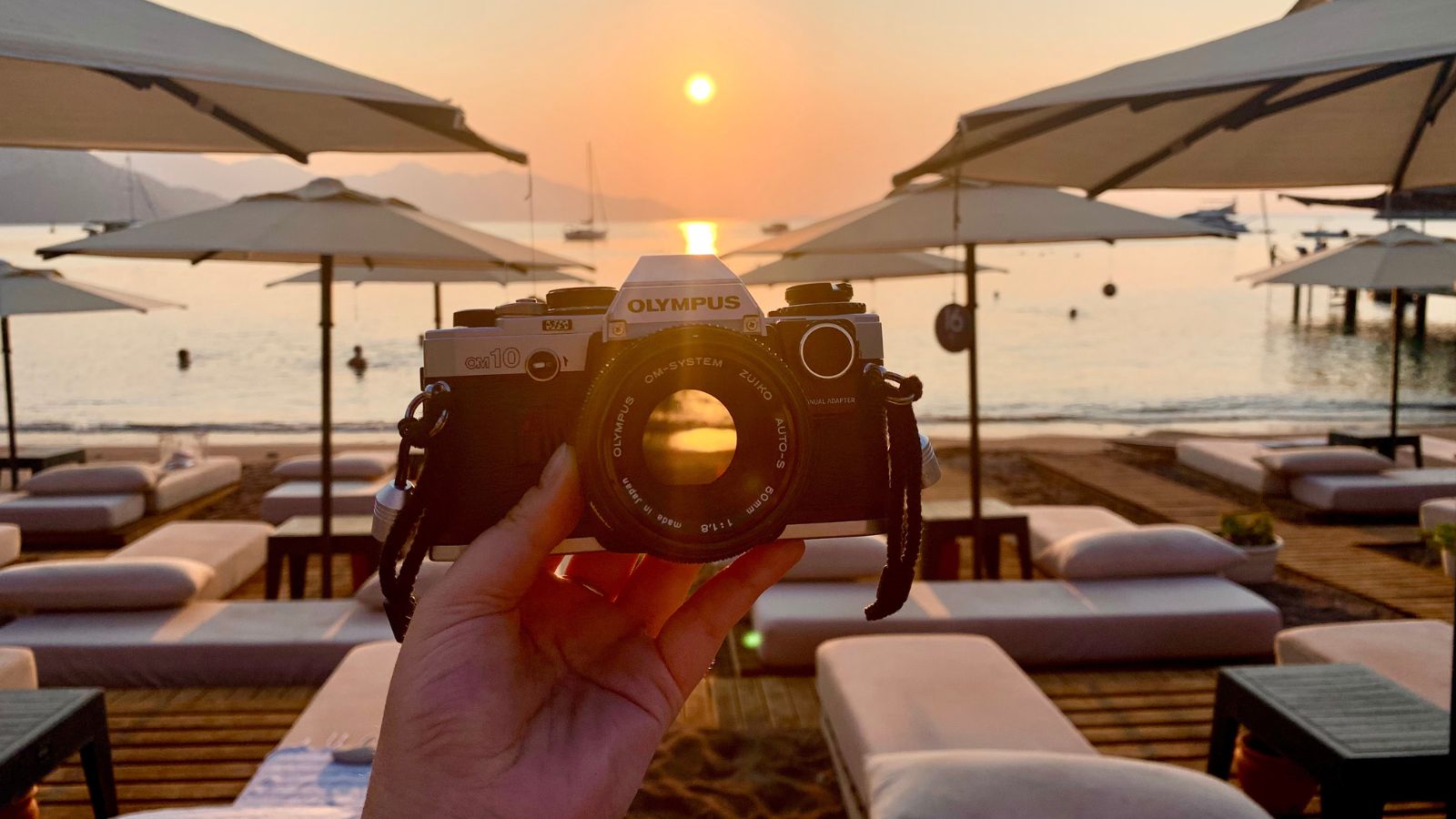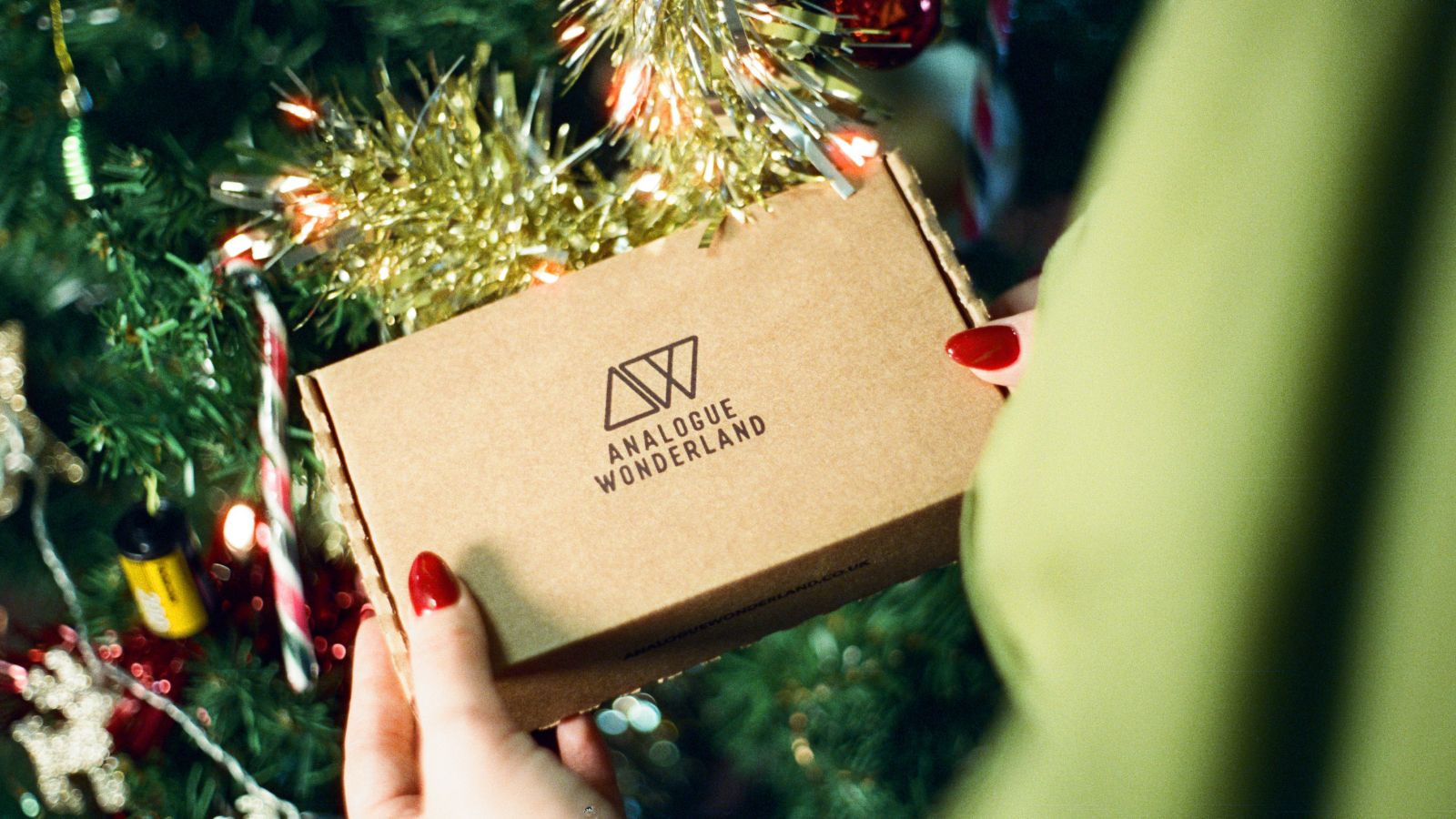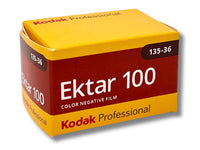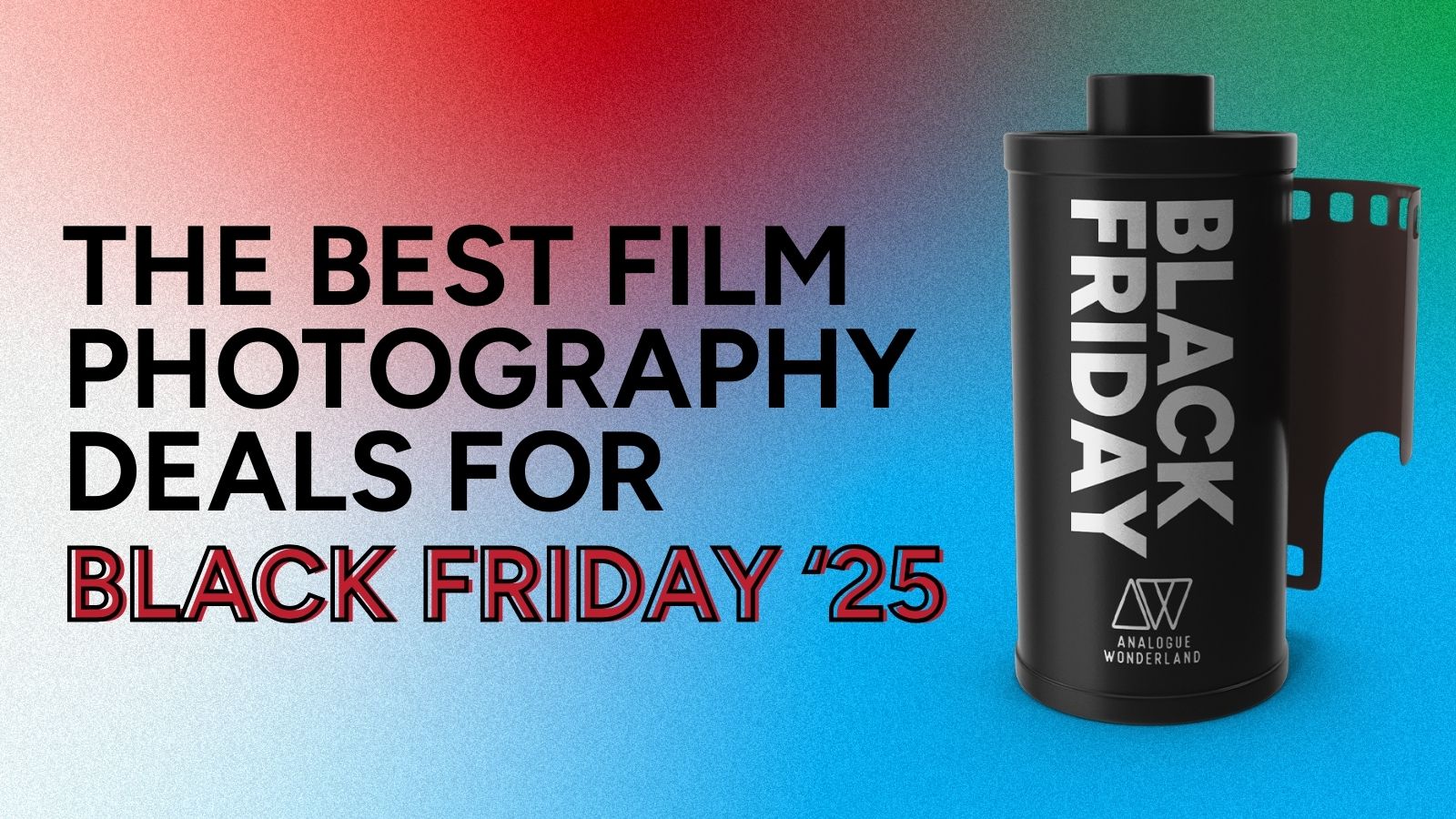Black Friday 2025 has landed at Analogue Wonderland, bringing some of our biggest film photography deals of the year - from discounted film and cameras to money-saving WonderLab processing offers, exclusive bundles, and festive specials available for a limited time only. Grab a great deal while stocks last!
Recent posts
Shop the article

Shooting 35mm Film in Turkey: What I've Learned
By Amy Farrer
A two-week holiday on the Turkish coast is tempting on its own, but knowing it would give me the chance to shoot film - slowly, and just for fun - made it even more exciting. Whilst the trip helped me capture some of my favourite film photos yet, it also came with plenty of lessons along the way. So, whether you’re planning to bring film on your next adventure (like Paul going to North Korea) or just curious about how different gear choices can impact your photography, read on for tips, insights, and a few fun stories from my journey!
Which cameras and what films? Decisions, decisions...
Packing for a 2 week holiday is never fun. But whilst most people might be thinking about what outfits to pack, for us film photographers, it's all about the gear that’s coming along with us. Can anyone else relate to the stress of last-minute packing? 😅 My film kit, of course, was planned weeks in advance. Priorities, right?
Choosing the cameras
The first decision I had to make was which cameras would accompany me. Sand, sea, and cameras are not always the best mix, so I needed to be extra careful about keeping my gear safe. For my ‘everyday’ cameras, I decided to go with two point-and-shoots that are easy to handle and beach-friendly. Originally, I hoped to take my Canon Sureshot 90u as it’s compact and perfect for quick shots. But after multiple attempts, I couldn’t get the film to load - looks like it’s next in the queue to be fixed! In the end, I chose the Olympus XA1 and the Minolta Riva Zoom Pico – both of which are small, reliable, and have a built-in flash for those evening shots.
The bigger question was which SLR to bring along. My Olympus OM10 had just returned from being fixed in Edinburgh, thanks to the talented Dan Ho. With its recent refresh, it was the perfect chance to give it its first post-repair adventure. Given the stunning light and picturesque surroundings, I knew this holiday called for high-quality film to capture every detail. And now that the ISO 400 limitation on my OM10 had been fixed, I could finally embrace some slow films!
The film selection process
Next up - choosing the films, arguably the most exciting part! There are so many top colour films available. I aimed for a good mix of professional-grade films like Kodak Ektar 100, Kodak Ektachrome, and Pro Image, as well as some fun, experimental films like Lomography Lomochrome Purple and Turquoise, dubblefilm Jelly, and Harman Phoenix. I also packed a few everyday classics, including Kodak Gold, Ilford Ortho 80, and Santacolor 100 (one of my new favourites). In total, I packed 14 rolls of film, saving the best for those ‘wow’ moments with the Olympus OM10.
Prepping for airport security
Packing film for travel means one critical step: protecting it from airport X-rays. To avoid any damage from scanners, I made sure my films were easily accessible for hand-checks at security. I opted for the large Reusable Travel Film Pouch from Moment, removing all packaging to make the rolls easier to inspect. The pouch is perfect for travelling, and with the Analogue Wonderland “Do Not X-Ray” sticker attached, I was ready to go. I’ve also heard good things about the The Domke Filmguard Bags from the film community, but as they’re not transparent, some argue that it might cause more hassle at security.

I recommend checking out Moment’s Reusable Travel Film Pouches in Small 1L and Large 2L. (More stock coming soon!)
Thankfully, UK airports are generally well-prepared when it comes to handling photographic film. At Birmingham Airport, my films were hand-checked with no issues. For fellow travellers, I’d recommend looking into this guide that provides information on how different airports across the globe handle film checks. We also have a blog post with tips on travelling with film if you want to take a look before you fly.
Colour vs. black and white
I knew I wanted to shoot some black and white film to make the most of the bright Mediterranean light and harsh shadows. Little did I know that these B&W images would become some of my favourites from the holiday! That’s the beauty of film - you never know exactly what you’ll get until the photos are developed. If I’d have known, I would’ve captured more in monochrome! But there were also so many colour emulsions I wanted to try that made it hard to narrow down my choices.
One of the highlights of the trip was capturing the vibrant bougainvillaea outside our apartment in Turunç. I was so mesmerised by the colours and beauty of it that I shot half a roll of Kodak Ektar 100 right there in the garden! It’s amazing how excited you can get about light and colour - and when you’ve got a good camera in hand that’s even better!

What a beautiful scene to wake up to every morning. Oh how I wish this was my view from my bedroom in the UK!
I also made a mental note to try shooting the same scenes with different emulsions, both colour and black and white, for comparison. This particular frame (below) became central to my comparisons! The elements in this scene really pop - both in colour and black and white.

The lines and colours of this frame caught my eye, captured on Ilford Ortho 80 (left) and Kodak Ektar 100 (right).
The results of the comparisons were fascinating - especially when I captured the mosque at the heart of the village on three different films. Each film brought a unique texture and mood to the scene. Candido 200 adds that pop of colour with its movie film tones, compared to Kodak Ektar which has more of a clean and true colour representation, and Ilford Ortho 80 with its deep black shadows and crisp white highlights.

Turunç's mosque and taxi rank, captured on Candido 200 (left), Ilford Ortho 80 (middle) and Kodak Ektar 100 (right).
Shooting black and white film feels entirely different from colour. It’s almost like you have to switch on a different part of your brain or put on the ‘B&W hat’ to see things in monochrome. Monochrome transforms the ordinary into the extraordinary, emphasising light and shadow in ways colour can't.

The interior of Jojo’s Beach Bar, captured on Ilford Ortho 80.

The magic sparkle of the sun reflection on the sea, captured on Ilford Ortho 80.
Capturing the sunrise
Unfortunately, the way the village of Turunc is situated means that the evening sunset can’t be seen as it travels behind the mountains, which is such a shame! But there’s a silver lining. The sunrise beautifully travels from one side of the bay to the other so that’s the moment you need to see (and capture on film!)
Kodak Ektachrome 100
I knew I needed something special to capture my first sunrise shoot... enter Kodak Ektachrome 100 🙌 I had never shot this film before - or any slide film for that matter - so it felt like a bold choice. But with a collection of amazing films at my disposal and plenty of sunrises ahead, I figured it was a risk worth taking!
When the lab told me that pushing E6 film isn’t really an option (after I had set the ISO to 200 for more light), my expectations were low. Weeks went by with a mix of doubt and curiosity... but when I finally saw the results, I was pleasantly surprised. The gamble paid off!

Ektachrome brings out much cooler tones which is a striking contrast to the warm hues of Santacolor.

As the sun rises, the warmth gently emerges with subtle, true-to-life colours. I'm really happy with the composition here and how the sun aligns perfectly atop the mast!

Sometimes the image you had in mind doesn't always work out, though. These two are underexposed and could've done with an extra stop or two of light. (Can you spot a little furry friend in the left frame?!)
Santacolor 100
Luckily, the sunrise experience was so incredible that I knew I needed a second go. This time, I opted for the roll of Santacolor (pushed again to ISO 200) in the hope that this would be the backup film in case I didn’t quite nail Ektachrome. Little did I know I'd fall in love with the results from Santacolor - and much preferred them to Ektachrome! I was blown away by the fiery red tones and the sharp contrasts created by pushing the film.
I love seeing the gradual change in colours from soft pink to vibrant orange as the sun travels through the sky too. Note to anyone who likes a lie in on holiday: make sure you see (and capture) the sunrise at least once, it’s so worth it!

It’s so nice to have incredible scenes like this captured on film forever. It’s not one you want to forget!

I’ve got my eye on this one to be printed and framed in my living room! I love how pushing the film a stop increased the contrast in the shadows.

I couldn’t resist photographing this cat enjoying the morning sun 😻
These images make it clear - Santacolor won me over with its warm tones, adding a striking glow that makes the scene truly shine. That said, I love having two different versions of the Turunç sunset. The cool tones of Ektachrome (E100) still capture the peacefulness beautifully. I’d definitely shoot with Ektachrome again, but next time, I’d seek out more colourful subjects in a brighter, more consistent light to shoot at the intended box speed of ISO 100.
Quality > quantity
Looking back at my photos, I wish I had packed an additional SLR and more higher-quality films. It’s easy to get caught up in capturing everything 'for the memories' on holiday, but since I’ve visited Turunç many times, this trip called for beautiful, intentional film shots. The images would have been far more impactful if shot with a better camera or emulsion. I’d rather have taken fewer rolls and focused on more mindful photography with my OM10, rather than wasting snaps on point-and-shoots. But that’s all part of the film photography journey!

The apartment pool and gardens, shot with the Olympus OM10 loaded with Kodak Ektar (left), and the Minolta Riva Zoom Pico loaded with Candido 200 (right).
It’s fascinating how the same scene can look completely different depending on the camera and film emulsion used - choosing the right combination is crucial! In hindsight, I wish I’d shot Candido 200 with my OM10, as its colour tones are stunning, but a low-quality point-and-shoot just didn’t do it justice. That said, let’s take a moment to appreciate the clean, crisp colours of Kodak Ektar! 🤌✨

Beach signs captured on the Olympus OM10 loaded with Kodak Ektar (left), and the Minolta Riva Zoom Pico loaded with Kodak Gold (right).
While this isn’t a knock on Kodak Gold - it’s a fantastic emulsion - it just didn’t shine when paired with a point-and-shoot. On the other hand, its higher-end counterpart, Ektar, captured the scene beautifully. It may seem obvious, but investing in higher-quality film (and a solid camera) really does pay off if you’re after quality, printable results!
Flying back to the UK
It was time to head back to the UK 😢 and pluck up the courage to request a hand check for my film at Dalaman Airport. We were told there’d be extra security and x-rays at the entrance, raising the risk of the film being scanned twice. Thankfully, our ambassador Tom Warland, who’d flown from the same airport a couple of weeks earlier, gave me a great tip to get past the language barrier: show a translated message on your phone politely asking for a hand check. It worked - until the staff returned, insisting it had to go through the scanner. On the second attempt, though, I succeeded. YAY!
Although there was some anxiety about the scanner ruining my film, the risk was low since all my rolls were under ISO 400. After developing them, I’m happy that there were no noticeable issues. I remember reading an article in Issue 22 of SilvergrainClassics, where Lina Bessonova tested airport scanners on film. She observed base fog and colour shifts in films exposed to CT/X-ray scans, but mainly with ISO 400 and above. Knowing that, I felt confident my lower-ISO films should be safe even if they went through the scanner.
Key learnings
I was thrilled when I saw my scans had been finished by the photo lab and were ready on my AW account - 9 rolls to review made it the highlight of my day! Although some rolls from my point-and-shoots were a bit of a write-off, the quality of the images from my OM10 made up for it. Looking back, here are a few tips for shooting film on holiday:
- Know your films: I didn’t realise you can’t push E6 films, so when I returned and the lab warned me that shooting Ektachrome at ISO 200 might not yield great results, it was a lesson learned. Seeing as I actually preferred the Santacolor sunset results in the end, I wasn’t too mad about it.
- Bring more film than you think you'll need: I packed 14 rolls and shot 10, but I wish I’d used them all. You’re better to overpack and not be left wanting or needing more! I left out some gems like Harman Phoenix and Lomography Purple which would’ve yielded interesting results in the Mediterranean sun.
- Opt for an SLR over point-and-shoots: I thought point-and-shoots would be convenient at the beach or on the boat, but in hindsight, I wish I’d brought two SLRs for better results.
- Print your photos: Unlike phone snaps that stay on your device, film captures more personal memories. I’m planning to print and frame my favourites so I can appreciate both the holiday and my photos more. I’d definitely recommend this to others.
- Shoot more black and white: I only shot Ilford Ortho 80 in the end, despite also packing Kodak T-MAX 100, but the results were stunning. I regret not bringing more low ISO black-and-white films to take advantage of the bright light we’re not now likely to get in the UK.
So, I’ll leave you with a couple of closing messages. Shoot film for fun when you can. Take advantage of the bright light. Prioritise quality of images over quantity of images. And sometimes, it’s worth overpacking (film). Happy holidays and happy shooting! 📷☀️
What are your top holiday reflections this year?
Ready to dive in?
Keep Reading
View all
Christmas 2025: Shipping & Opening Hours
Christmas 2025 is fast approaching! To make sure your analogue goodies arrive in time, take note of our last shipping dates, plus opening and operating hours over the festive season. We've got everything you need to gift the magic of film photography this Christmas!

Film Photography Christmas Gift Guide 2025: Analogue Wonderland
Capture the magic of Christmas with film - no filters needed. Our 2025 Film Photography Christmas Gift Guide 2025 is packed with thoughtful presents for every type of shooter, from curious beginners to seasoned photographers. Discover film stocks, cameras, and creative accessories that will make this festive season truly memorable.
Subscribe to our newsletter 💌
Sign up for our newsletter to stay up to date on film photography news, sales and events:
Free Tracked Shipping
On all UK orders over £50
Passion For Film
An unbeatable range and an on-site lab
Our Customers Trust Us
Thousands of independent 5* reviews
All Deliveries are Carbon Neutral
Independently audited and verified by Planet
- Opens in a new window.








5 Comments -
Vince Docherty • -
David Burch • -
Emil • -
Simon Manley-cooper • -
Colin Henderson •
The section about the trees around your apartment, and wishing you’d tried the Candido200 in the OM10, is exactly what I was thinking as I looked at the photos. I didn’t get to shoot any AW film on a recent trip to Italy, but next month I will go with a few new choices based on your article.It was also good to read adult English in a blog post! Well done!
I always travel “light” with these days two SLR’s one film, one digital and say three lenses. That’s about 4kgs in the hand luggage. You then have digital days and film days with the phone for selfies and a bit of digital on the film days. That works most of the time however you then need to decide what film types to take as you can only use one at a time. Slow and colour for the Med?
Great article and lovely photos! Kodak Ektar 100 is my personal favourite when it comes to shooting colour. I’d suggest you upgrade your OM10 to OM1 to get the most out of that roll.
About the airport X-ray scanners, no need to worry about any sort of damage to the film as long as its ISO is not higher than 800. I’ve passed more than a hundred rolls through those scanners with no issues at all.
Hi Amy, thank you so much for sharing your holiday pictures. Not only lovely results but have learned a lot. I love Ilford Ortho 80 and the Ektar 100 but I have to admit that your results with SantaColour were amazing, I shall certainly try it but may not be trying the Candida! I have posted some results of my Costa Del Sol visit on the beach shot with Canon 3000N with 50mm prime lens, love the vibrant colours.
Excellent review of your films on holiday. I love shooting black and white film especially 120 format through my original Yashica 124 TLR, thank you again for a great review.